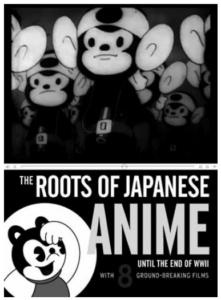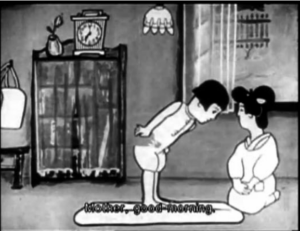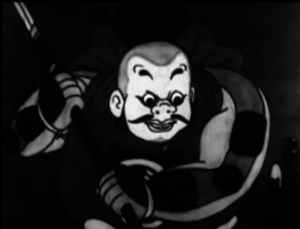DIRECTED BY: MITSUYO SEO, KENZŌ MASAOKA,
NOBURŌ ŌFUJI, YASUJI MURATA, YOSHITARO KATAOKA
ZAKKA FILMS
DVD, 92 MINUTES, 2008
Reviewed by Paul Dunscomb
The DVD Roots of Japanese Anime brings together eight early examples of Japanese animation from the 1930s to 1942. Four of the short films, The Village Festival, Song of Spring, The Monkey Masamune, and Chameko’s Day date from 1930–31; three others, Chinkorobei and the Treasure Box, Danemon Ban—The Monster Exterminator, and Benkei and Ushiwaka are from the mid to late thirties. The set concludes with the 1942 Navy Ministry-sponsored Momotarō’s Sea Eagle.
Calling these films anime might be a shade misleading, since the few early Japanese experiments in animation (of which even fewer survive) were largely inspired by their contemporaries in the West (particularly the US) and have little similarity to postwar anime either in terms of narrative, character design, or artwork. All eight films are black and white. Nevertheless, this is a fascinating, often charming, collection.
 The earliest Japanese animators worked with cut paper drawings, and the four early films utilize this technique. The Village Festival and Song of Spring, directed by Noborō Ōfuji, are essentially illustrated songs, while Kiyoji Nishikura’s Chameko’s Day offers only the most rudimentary narrative and dialogue. Only Yasuji Murata’s The Monkey Masamune is a fully realized story. This takes nothing away, either from their charm or from their technical sophistication, since they also represent some of the earliest surviving experiments with sound.
The earliest Japanese animators worked with cut paper drawings, and the four early films utilize this technique. The Village Festival and Song of Spring, directed by Noborō Ōfuji, are essentially illustrated songs, while Kiyoji Nishikura’s Chameko’s Day offers only the most rudimentary narrative and dialogue. Only Yasuji Murata’s The Monkey Masamune is a fully realized story. This takes nothing away, either from their charm or from their technical sophistication, since they also represent some of the earliest surviving experiments with sound.
By the late 1930s, technical proficiency and budgets had grown enough to utilize cel-animation (drawing character motion on individual sheets of celluloid, which was imported and expensive). Ōfuji’s Chinkorobei and the Treasure Box, Yoshitaro Kataoka’s Danemon Ban—The Monster Exterminator and Kenzō Masaoka’s Benkei and Ushiwaka nicely demonstrate the increased skill but also the still experimental nature of early animation in Japan.
Mitsuyo Seo’s Momotarō’s Sea Eagle is an important transitional film. At thirty-seven minutes, it was by far the longest animated film made to that date in Japan. It also demonstrates a degree of technical sophistication nearly equal to its American counterparts as well as the loving reproduction of “mecha” (machines) that would become an anime hallmark. This is a straight-forward propaganda piece—think “Pearl Harbor for Kids.”

Kiyoji Nishikura.1931. Seven minutes.

Kenzō Masaoka. 1939. Fourteenminutes.
Momotarō’s Sea Eagle might usefully be shown in class with wartime cartoons from Disney and Warner Brothers. One can compare differing approaches to putting forward a propaganda message through animation. The other films offer evidence of the place popular songs had in Japanese culture long before the existence of popular music genres such as J-Pop ever existed, a brief but fascinating look at urban life through the eyes of a little girl and the eager embrace of a new medium to tell old tales.

Mitsuyo Seo. 1942. Thirty-seven minutes.
The DVD itself features an insert with a helpful essay by Jasper Sharp describing the early development of animation in Japan and brief descriptions by Aaron Gerow, of Yale University, discussing the individual films. A short bibliography is also included. All together, these films show not only how far Japanese animation had come in the pre-war period, but also how much further it had to go to become the anime that we know today.

